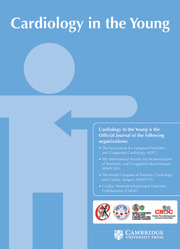No CrossRef data available.
Article contents
Incomplete Kawasaki disease with peripheral facial nerve palsy and giant coronary artery aneurysm: rare case report
Published online by Cambridge University Press: 19 February 2025
Abstract
Kawasaki disease is an idiopathic vasculitis that involves the participation of various physiological systems and the inflammation of small-to medium-sized arteries, resulting in the formation of aneurysms. It most commonly affects children under 5 years. The development of coronary artery aneurysms is a significant concern in the context of Kawasaki disease, rendering it the prevailing acquired cardiac condition among children. It has been observed that 1–30% of Kawasaki illness patients experience neurological complications. However, facial nerve palsy is uncommon, with a prevalence of only 0.9%. Infants with Kawasaki disease and facial nerve palsy tend to be under 6 months of age and had a higher chance to develop coronary artery aneurysms compared to those without facial nerve palsy whose condition was never treated.
- Type
- Brief Report
- Information
- Copyright
- © The Author(s), 2025. Published by Cambridge University Press



